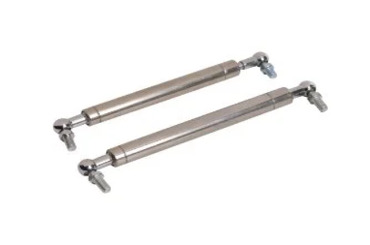If you are interested in our products ,please contact our team
Gas traction springs are a type of hydraulic machinery that offers support and control in various applications.
They function by compressing and expanding in response to pressure changes, ensuring stable and dependable force in different settings.
Despite their reliability, these springs, like all hydraulic equipment, can be damaged by several factors, some of which can be avoided by regular maintenance and proper care.
Overloading of springs
Overloading is one of the primary reasons that gas traction springs can become damaged.
If a spring is forced to bear more weight than it can handle, it may be damaged or even collapse altogether.
This could cause significant injury or equipment damage, making it crucial to utilize gas traction springs that are rated for the weight they will be supporting.
Additionally, it's critical to ensure that the gas traction spring is accurately installed and positioned since improper installation can also lead to overloading and harm.

Exposure to harsh or corrosive environments is another common reason for gas traction springs to become damaged.
These springs are often utilized in settings where they are exposed to moisture, chemicals, or extreme temperatures.
If a spring isn't built to endure these conditions, it may become corroded or damaged over time, resulting in decreased performance or even collapse.
To avoid this kind of damage, it's vital to select gas traction springs that are intended for the particular environment in which they will be used and to make sure that they are correctly maintained and cleaned.
Improper application is another factor that can cause damage to gas traction springs.
For instance, using a spring that's intended for a specific application in another application may harm the spring, just like using the spring outside of its prescribed operating temperature range.
Furthermore, using a spring that is worn or damaged may cause additional damage, so it's important to routinely inspect and replace gas traction springs to ensure that they are in proper working condition.
Irregular maintenance
Neglecting maintenance is another aspect that can cause damage to gas traction springs. As time passes, gas traction springs can wear down or become damaged due to regular usage, and routine maintenance can help prevent this type of damage from occurring.
This involves activities such as lubrication, cleaning, and inspection of the spring to make sure it's functioning correctly.
If maintenance isn't carried out regularly, it may result in reduced performance or even failure of the spring over time.
Incorrect storage and handling can also lead to damage to gas traction springs.
If, for instance, a spring is stored in an area where it's exposed to moisture or extreme temperatures, it may deteriorate or become corroded over time.
More so, if a spring is mishandled or dropped while installing or removing it, it may become damaged or deformed, causing reduced performance or failure.
To prevent this kind of damage, it's important to handle and store gas traction springs correctly and to utilize suitable tools and equipment during installation and removal.
Lastly, age and wear are also factors that can cause damage to gas traction springs.
Even if springs are properly maintained, they may become worn or damaged over time due to normal wear and tear and may need to be replaced to guarantee continued performance and safety.
Additionally, springs that are used often or in high-stress applications may wear out more rapidly, requiring more frequent replacement.
It's crucial to frequently examine the state of gas traction springs and replace them as needed to prevent damage or failure.
Gas traction springs provide vital support and control in hydraulic applications but are susceptible to damage from overloading, harsh environments, misuse, lack of maintenance, improper storage and handling, and age and wear.
To ensure safety and performance, choose the right spring, install it correctly, and conduct regular maintenance.
Don't let damaged or worn-out gas traction springs compromise the safety and efficiency of your hydraulic equipment.
Upgrade to high-quality gas traction springs today and enjoy reliable and consistent support and control. Contact us now to learn more!
------WebKitFormBoundaryBGWr9dhD8IIHjy2I Content-Disposition: form-data; name="abstract" Gas traction springs are a type of hydraulic machinery that offers support and control in various applications. They function by compressing and expanding in response to pressure changes, ensuring stable and dependable force in different settings. Despite their reliability, these springs, like all hydraulic equipment, can be damaged by several factors, some of which can be avoided by regular maint